Here at the RBGE we have just finished digitising our collection of British Rhodophyta (Red Algae), a total of 7850 specimens. Our collection dates from present day right back to 1777 with the Menzies Herbarium. Red algae get their colour from pigments such as Phycoerythrin and Phycocyanin that block or mask other pigments such as Chlorophyll (green) to create beautiful shades of red and pink.
They have several different forms;
Feathery algae:
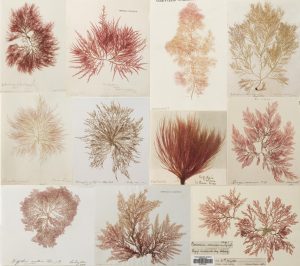
Top row: Neosiphonia elongella, Hypoglossum hypoglossoides, Gloiosiphonia capillaris & Cystoclonium purpureum. Middle row: Naccaria wiggii, Spondlythamnion multifidium, Halurus floculosus & Heterosiphonia plumosa. Bottom row: Griffithsia corallinoides, Ptilota gunneri & Plocamium cartilagineum.
Large simple fronds of colour:

Top row: Polyneura bonnemaisonii, Nitophyllum punctatum & Porphyra umbricalis.
Bottom row: Kallymenia reniformis, Dilsea carnosa & Wildemania miniata.
Branched forms:

Clockwise from left: Palmaria palmata, Furcellaria lumbricalis, Polyneura bonnemaisonii, Scinaia interrupta & Chondrus crispus.
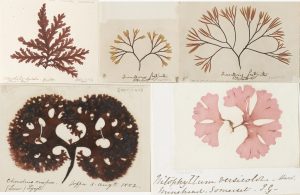
Top row: Odanthalia dentata & Furcellaria lumbricalis.
Bottom row: Chondrus crispus & Drachiella heterocarpa.
Leaf like shapes:
Some even produce calcium carbonate and are most commonly seen as coral structures or crustose on the rocks, but some take on delicate articulated forms.
Coral:
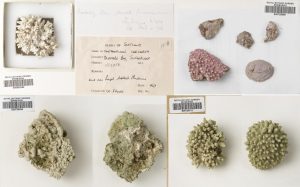
Top row: Phymatolithon calcareum & Lithothamnion glaciale.
Bottom row: Phymatothamnion purpureum & Lithothamnion glaciale.
Crustose:
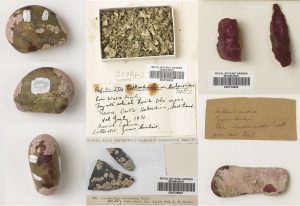
Clockwise from left: Hildenbrandia crouaniorum, Mesophyllum lichenoides, Rhodochorton purpureum, Peyssonalia dubyi & Lithophyllum orbiculatum.
Articulated:
Then there are the few strange genera like Meiodiscus which has a triangular structure…
…and Rhodothamniella which looks like pink fur.
They are usually mounted flat on paper/card or in boxes, some however are mounted on glass or behind it! Some are still attached to sea shells, broken ceramic and large hefty rocks!
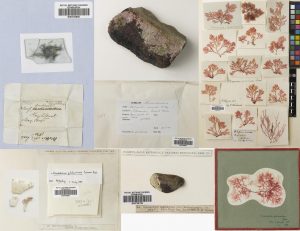
Top row: Oscillatoria sp. on glass slide, Mastocarpus stellatus on large rock & a single collection of Plocamium cartilagineum all on individual sheets. Bottom row: Atractophora hypnoides on broken ceramic, Titanoderma pustulatum on a mussel shell & Plocamium cartilagineum mounted and framed behind glass!
Several species can be eaten such as Dulse (Palmaria palmata), Carrageen Moss ( Chondrus crispus & Mastocarpus stellatus) and British nori or rose nori ( Porphyra nereocystis) to name the most common. Gracilaria, Gelidium and Pterocladia are all used to make agar which has important roles in many industries.
The RBGE has two large collections: The Greville herbarium from the 1820s to 1850s and the D.E.G. Irvine Collection from the 1940s to the 1980s. Other collections worth mentioning are the G.W.Traill herbarium from the 1870s to 1890s, W.W.Evans herbarium from the early 1900s and the oldest belonging to the Menzies herbarium from 1777 to the 1820s.
Our small collection of Cyanophyta (Blue-green Algae) was also digitised along with the Rhodophyta. We have approx. 250 specimens that are mostly from 1820 to 1900 and some are still beautifully blue!
Article written by Rebecca Camfield

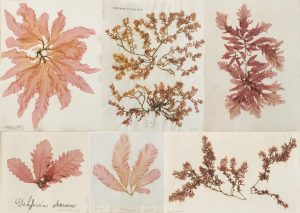

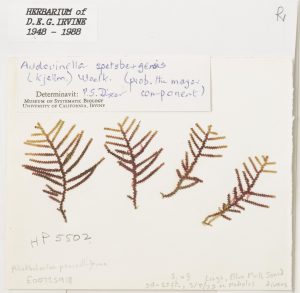
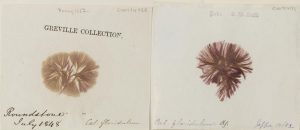
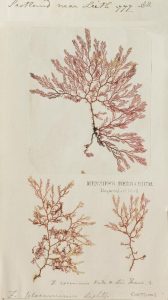
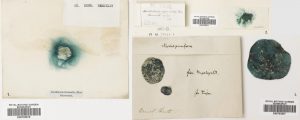
Sunny
Hello. I’m Sunny. I’m Korean.
I think you have difficulty understanding my relpy because I am not good at English. I am sorry about that. I read this article impressively. I have a question about using image. I want to use this image(Branched forms), but I wonder how to get permission. I have the possibility of being commercially available, so I would like to ask you courtesy. I am very sorry if I offended you.
Thank you for reading, I will wait for your reply.
Robyn Drinkwater
Hello Sunny,
Thank you for getting in touch. Unfortunately all of the images used in this post are for Non-commercial use, so cannot be used in any commercial project.
Robyn
Rura
Hello. I wanted to ask how it shows Mastocarpus Stellatus as Chondrus Crispus and Chondrus Crispus as something else. Third picture from the top. When researching, Mastocarpus Stellatus is shown as the one the picture is saying Chondrus Crispus while the one above it with the wider body and tips is Chondrus Crispus. What changed? Hope I don’t sound rude, I’m honestly interested in learning about the info from before to now and what’s going on.